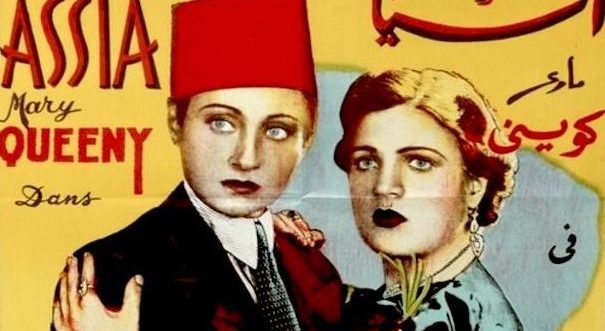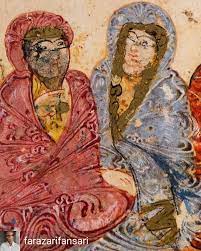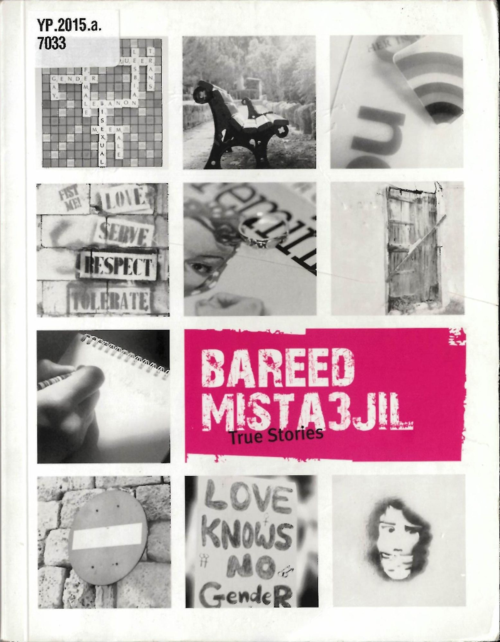
Social
Tongues in Cheek: The Queer Love Languages Hiding in Plain Sight
| Love is a language that transcends borders, religions, societies and genders. It need not be measured through policies or customs but through mutual respect and adoration. Across the Middle East more and more queer love stories are being told. However, for women who are part of the LGBTQ+ community, romantic and intimate love is often marginalised or erased. The double-edged sword of being female and queer means being subjected to homophobia and sexism.
That does not mean that stories of romantic love between women don’t exist. The only trouble is that Middle Eastern history – or any global history – is not measured through intimate displays of love. But if you look carefully, you might find queer feminine love hiding in plain sight.

By JDEED Studio
By Matilda Coughlan
This article is an exploration of five historical instances of romantic love between women. These stories are told through the prism of the five long languages; acts of service, physical touch, gift giving, words of affirmation and quality time. These small and intimate signs of love supersede the confusion of labels often placed on women. You may notice that so far I have avoided using the word ‘lesbian’. Well, there’s a reason for that. This can be a loaded term with hidden layers of Eurocentrism, limiting boundaries and strict definitions. However, I will be using it from now on, but only in line with the definition given by Dr Iman Al-Ghafari:
“I perceive the lesbian as an infinite sensual, mental, spiritual, and sexual awareness that is incarnated in a female body; an absorbed consciousness that exists prior to sex, love, language, gender representation, and history.”
Much like love, lesbianism is ineffable. But when trying to amplify the voices of romantic, feminine love, these five stories told through the five love languages are a meaningful place to start.
Acts of Service – Hind Bint al-Nuʿmān and Hind Bint al-Khuss al-lyadiyyah

Bint el-Basha el-Mudir, 1938 Movie Poster
The love between al-Zarqāʾ and Hind bint al-Nu’mān was so great that when al-Zarqāʾ died, Hind bint al-Nu’mān cut her hair, wore only black and rejected all worldly pleasures. The first love language is highlighted through these lovers, who are known as the first recorded lesbian relationship in Arab history. Their story is told in Ali ibn Nasr al-Katib’s Encyclopedia of Pleasure, a 10th century erotic treatise. Hind bint al-Nu’man was Christian and daughter to the last Byzantine king of Hira, and Al-Zarqāʾ is a legendary poet. The love between al-Zarqāʾ and Hind bint al-Nu’man is praised in this erotic treatise as a testament to the undying loyalty and faith between women. Hind bint al-Nu’mān even built a monastery to commemorate the love between herself and al-Zarqāʾ.
Acts of service are about doing things for others without hope of anything in return. Hind bint al-Nu’man’s dedication to her lover – even after her death – is an outstanding act of service. This isn’t
just making a partner food or doing the dishes; this is complete and utter dedication. It is no wonder that this couple now exemplifies great and undying love between women.
Quality Time – Badria and Aisha

Bint el-Basha el-Mudir (1938) – IMDb
Spending time with a loved one is not often perceived as a grand romantic gesture. However, the intimacy fostered by this love language cannot be underestimated. In the movie Bint al-Basha al-Mudir (1938), directed by Ahmed Jalal, Badria falls in love with Aisha after the time they share together. The film begins with the tragic death of Aisha’s brother, an event that means Aisha must financially support her family. She disguises herself as a man to work as a tutor on a large estate. In doing so she attracts the attention of Badria, one of the daughters of the estate owner. Throughout the course of the film Badria spends a lot of time with Aisha and attempts to seduce her in what is widely agreed to be one of the first homoerotic scenes in Arab cinema.
Although this scene may not have been intentionally queer, the love that Badria feels for Aisha is in many ways authentic. Furthermore, the introduction of cross-dressing – an act that challenges gender norms – adds an inherently queer dimension to their story. Spending time with a partner is infinitely romantic, regardless of what activity is chosen – listening to music, reading, or in the case of Aisha, tutoring. This film is almost 100 years old, and yet it is testament to the magic of quality time between two women.
Physical Touch – Taese and Tsansno
The next story is a little less romantic, a little more scandalous. A record survives from a 5th century Egyptian monastery describing the punishments of Taese and Tsansno. One day, the monastic superior Shenute came across the two women engaging in what is described as homoerotic acts. In other words, a case of physical touch. Ironically their loving act was greeted with a violent physical reaction as it is recorded that both were subjected to a series of beatings. Although not much is known of these two women beyond their misdemeanour, it is now thought to be the first recorded incidence of lesbianism in Middle Eastern history. It is unknown whether these two were lovers or
friends. Were they acting out of romance, confusion or sheer boredom? All that is known is that their love language was intimate enough to warrant punishment.
Physical touch is a universally recognisable sign of affection that encompasses a variety of different actions. It is also the love language most likely to elicit punishment. While quality time and acts of service can be perceived as heterosexual, embarking on a physical queer relationship requires a huge amount of emotional strength. Whether this is a hug, a kiss or something a little closer to what Taese and Tsansno were getting up to, for lesbians, there is bravery behind physical touch.
Gift Giving – Rima and Siham

ArticleKarim.pdf (alphavillejournal.com)
Rima – one of the five protagonists in Sukar Banat (2007) – gives the object of her affection a great gift. It is widely agreed by reviews and film audiences that Rima is a lesbian. Although the director Labaki does not directly address her sexuality, she is seen to wear boyish clothes and has an overall androgynous feel. In this film she meets Siham, who comes to get her hair done. Although there is no overt display of lesbianism, the atmosphere between the two women is palpable. The final scene in the film shows Siham returning to the salon, not just for a simple trim but a transformation. She leaves with a wide smile and a short haircut. Rima has given her the gift of liberation, not just through the haircut but through what it represents – the subversion of gender stereotypes. This gift facilitates rebellion against traditions and customs for women.
Rima’s gift highlights the value of giving people the opportunity to be their authentic selves. More often than not women are expected to look and behave a certain way. Therefore while gift giving can be chocolate or flowers or something tangible, the opportunity to be seen is arguably the greatest gift of all.
Words of Affirmation – Bareed Mista3jil and Queer Arab

The final love language is words of affirmation. For this it makes sense to look further at the concept of women loving women as a wider community. Bareed Mista3jil (2009) is a collection of 41 stories, all of them true accounts given by individuals from across Lebanon. This book outlines the experiences of queer people including lesbians, bisexuals and women questioning their sexual identity. The stories speak of love, pain, shame, overcoming and everything beyond. These words are a romantic gesture to all women whose sexual and gender identity has left them feeling alone and unloved. Bareed Mista3jil has facilitated love as a communal spirit. As the introduction of states, “tradition and public views of morality are often just as powerful as religious texts”.
In this context the words of affirmation are not whispered words between two lovers. Instead, they are affirming something far broader; they are amplifying voices and identities that are subject to extensive erasure. This authenticity is a great display of love.
By celebrating these five stories of lesbian love and the five love languages they represent it becomes possible to truly understand the spirit of these relationships. From acts of selfless service to the transformative power of quality time, from the controversy of physical touch to the rebellion of gift-giving and finally to the resounding words of affirmation that echo through the stories of individuals. These languages of love show that romantic and intimate relationships between women know no boundaries. They transcend time, culture and stigmatisation. The relationships, behaviours and most importantly love of these individuals highlights the nature of pride; to love fully and freely.






0 comments